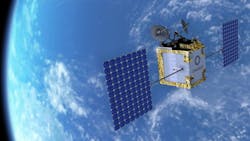Northrop Grumman to broaden constellations of commercial satellites for path-agnostic military communications
WRIGHT-PATTERSON AFB, Ohio – Military space communications experts at Northrop Grumman Corp. broaden the number of commercial satellites to distrubute important information to military forces for high-speed decision-making.
Officials of the Air Force Research Laboratory at Wright-Patterson Air Force Base, Ohio, announced a $79.3 million order earlier this month to the Northrop Grumman Mission Systems segment in San Diego for the Defense Experimentation Using the Commercial Space Internet (DEUCSI) program.
DEUCSI seeks the ability to move and share data seamlessly among a wide variety of fixed and mobile operating locations using constantly available, high-bandwidth, beyond-line-of-sight communications.
This military communications contract seeks to establish the ability to communicate with military platforms via several commercial space internet constellations in various orbits using common user terminal and hardware.
This order seeks to expand the number and types of satellite constellations with which the terminals can communicate and will include waveforms capable of communications through military as well as commercial satellites.
DEUCSI space-based capability will be called path-agnostic communications because its users will be able to communicate reliably to any location in the world without explicitly specifying which nodes of a communication network to use.
The vision for path-agnostic communications is becoming possible due to the burgeoning commercial space industry, Air Force officials say. Several commercial companies plan to establish space internet constellations consisting of hundreds to thousands of commercial satellites, each to create global internet services.
The DEUCSI program seeks to establish resilient, high-bandwidth, high-availability Air Force communications and data sharing capabilities by leveraging developing commercial space internet networks.
This approach differs radically from traditional military satellite communications programs in which the government typically specifies and funds every aspect of the program, Air Force researchers point out.
Instead, taking advantage of the commercial space internet will concentrate government efforts on the few areas that are unique to Air Force applications.
The project has three phases: establish connectivity between several Air Force sites using commercial demonstration satellites and terminals; expand connectivity to many Air Force assets by proliferating user terminals to several locations and vehicle types; and special experiments to address military-unique requirements not otherwise met by commercial space internet vendors.
For more information contact Northrop Grumman Mission Systems online at www.northropgrumman.com/who-we-are/business-sectors/mission-systems, or the Air Force Research Laboratory at www.afrl.af.mil.
About the Author
John Keller
Editor-in-Chief
John Keller is the Editor-in-Chief, Military & Aerospace Electronics Magazine--provides extensive coverage and analysis of enabling electronics and optoelectronic technologies in military, space and commercial aviation applications. John has been a member of the Military & Aerospace Electronics staff since 1989 and chief editor since 1995.
